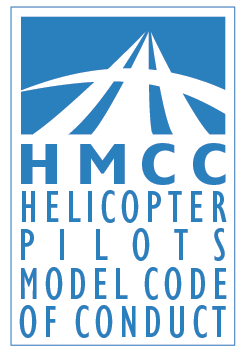 The Helicopter Pilots Model Code of Conduct (HMCC) was released today by the project’s Permanent Editorial Board. The HMCC offers recommendations to advance helicopter flight safety, airmanship, and professionalism. Developed by a team of helicopter experts, the HMCC draws upon decades of research as well as input from key helicopter organizations in both the private
The Helicopter Pilots Model Code of Conduct (HMCC) was released today by the project’s Permanent Editorial Board. The HMCC offers recommendations to advance helicopter flight safety, airmanship, and professionalism. Developed by a team of helicopter experts, the HMCC draws upon decades of research as well as input from key helicopter organizations in both the private
and public sectors, and builds upon the foundation of the Aviators Model Code of Conduct initiative, a project of over ten years. The Code applies to a range of operating environments, from primary instruction to commercial flight operations.
The HMCC articulates broad guidance a set of values to help a pilot interpret and apply standards and regulations, and to confront the real world challenges that could lead to a mishap. The Code provides a framework for how to think and act in situations that may not be covered by procedures, checklists, or operating manuals.
Fred Brisbois, Co-Chair, U.S. Safety Implementation Team, International Helicopter Safety Team stated, “The HMCC embodies the standards to which all helicopter pilots need to adhere. It should serve as the basis for private and professional pilots to take personal responsibility for how they conduct themselves as pilots and promote the growth of the helicopter industry. But most importantly, flying in accordance with this code will save lives!” Lindsay Cunningham, Manager, Aviation Safety, Eurocopter USA remarked, “It is nice to see such a clear, complete and concise standard for helicopter pilots that goes beyond the “minimums”. The HMCC promotes the high level of personal accountability and professionalism I think we would all like to see in our Bryan Smith, Safety Program Manager, Airborne Law Enforcement Association stated,he HMCC provides an accessible and practical guide for decision-making. Every pilot should regard it as an indispensable tool for aviation safety.”
The HMCC:
- promotes improved helicopter pilot training, conduct, personal responsibility and pilot contributions to the aviation community and society at large,
- encourages the development and adoption of good judgment, ethical behavior, and commitment to continuous improvement, and
- supports improved communications between pilots, regulators, and others in the aviation industry.
- Pilot conduct and professionalism impact the entire aviation community, including its safety culture. Correspondingly, organizational safety culture affects pilot conduct. A voluntary, aspirational code of conduct can promote pilot proficiency and operational safety. The HMCC is just such a tool: a set of guidelines or recommended practices adaptable to each pilot and organizational need.
The Code of Conduct presents a vision of helicopter aviation excellence within its seven sections:
(1) General Responsibilities of Helicopter Pilots; (2) Passengers and People on the Surface; (3) Training and Proficiency; (4) Security; (5) Environmental Issues; (6) Use of Technology; and (7) Advancement and Promotion of Aviation. The Code is a living document and will be periodically updated to reflect changes in standards, practice, and the aviation environment.
The Helicopter Pilots Model Code of Conduct is the latest in the family of aviators’ codes including the Aviation Maintenance Technicians, Aviators, Flight Instructors, Glider Aviators, Light Sport Aviators, Seaplane Pilots, and Student Pilots Model Code of Conduct. Developed as a volunteer effort, each is available as a free public service along with supporting materials at www.secureav.com
For more information about the Helicopter Pilots Model Code of Conduct, contact [email protected]
